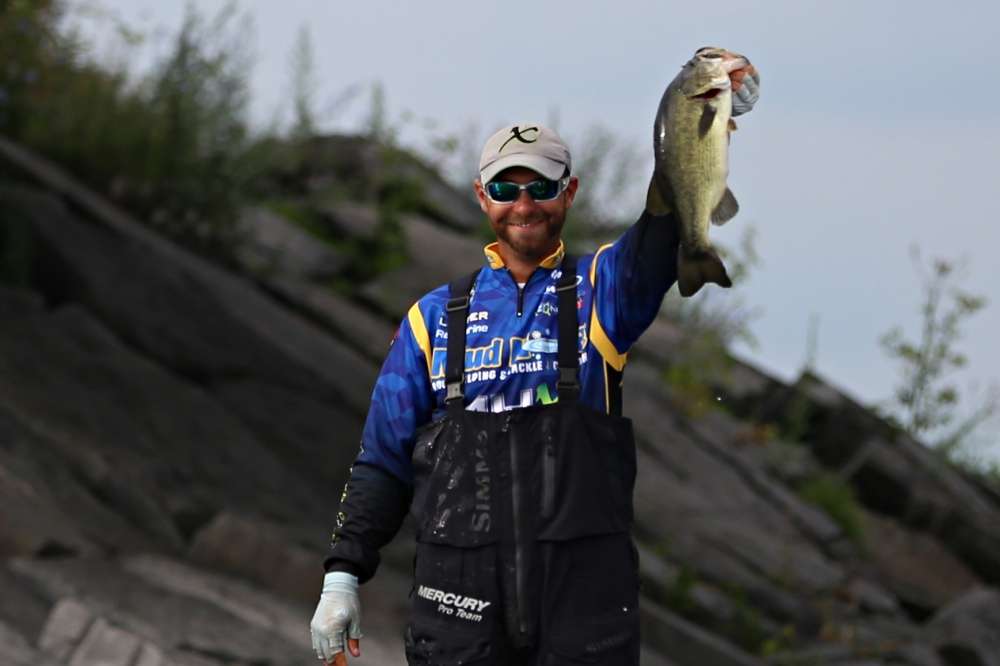
PLATTSBURGH, N.Y. — Fish for smallmouth and largemouth. Run south or stay up north. Tournament anglers familiar with Lake Champlain know that means a mixed bag of bass fishing is in play, and it’s happening this week at the Bass Pro Shops Bassmaster Eastern Open.
The third of fourth events on the 2018 Eastern Opens schedule began today and concludes Saturday. Most, if not all, of the nearly 200 pros and equal number of co-anglers predict the winning will take a mixed catch of largemouth and smallmouth.
Solely targeting just one or the other is out this week. The reason why is bass activity. The largemouth population is coming out of postspawn, the bass are hungry and getting fat. The smallmouth population is scattered and challenging to pattern in groups. That makes targeting both to complete the 20-pound-plus limits needed to stay in the game a must.
The big question is where to fill that mixed bag.
There are two options. One is making the roughly 140-mile round trip run to the south end of the lake near Ticonderoga, N.Y. Making the run to “Ti” as the anglers call it, comes with inherent risks and rewards.
The best largemouth fishing on the lake is there, due in part to the presence of aquatic vegetation. The lake bears a striking resemblance to the Potomac River, less the tide. Think grass, lily pads and shallower, off-colored water and you have a snapshot of the area and it’s fishing appeal.
The risk is just getting there and back. Slick calm days are rare on a lake stretching 100 miles from north to south. A boater’s worst enemy during summer is a south wind, and today it steadily blew from that direction at 10 mph with stronger gusts, not bad but enough to prolong the ride and eat into valuable fishing time.
The limited fishing area is another factor. The most productive areas are limited in size and don’t hold up to fishing pressure. The buzz during practice was the hot largemouth bite at Ticonderoga. During practice the fishing pressure evens out as boats come and go throughout the day. Things change during competition, when all the boats converge on the area and stay all day. In a 200-boat tournament, Ticonderoga rarely supports a three-day winning catch due to those factors.
That leaves open the other option, which is staying up north, maximizing fishing time, and tapping into the lake’s dependable smallmouth bite.
Which will it be: North or south, smallmouth or largemouth? The likely scenario is probably both.
“I’ve seen a lot of guys from here that usually fish up north, instead going south because Ticonderoga is really on,” said Jimmy Kennedy, a longtime Opens angler from Plainfield, Vt.
Kennedy doesn’t plan to join his buddies for a good reason.
“You get a better chance of catching a mixed bag up north, putting a good 17-pound limit of smallmouth in the livewell, and then going to look for a kicker 5-plus pound largemouth,” he added.
Carl Jocumsen, the Texas transplant from Australia, and also an FLW Tour pro, also plans to play his game conservatively and stay up north.
“Too many people go to Ticonderoga, catch a 20-pound limit and then go back down there and catch nothing,” said Jocusmsen, who’s fished six events here in recent years. “It’s a hero or zero kind of deal.”
“And, if you go down there on that second day and it turns off, then you are stuck down there, because there is nothing else to fish for other than the largemouth,” he explained.
Jocumsen said in past tournaments he made the run south three times, never cashing a check. The other three events he stayed north and put money in the bank.
Jocumsen has discovered what a lot of anglers are finding up north, and specifically in the areas known as the Inland Sea and the islands on the Vermont side of the lake.
“There are so many big smallmouth and big largemouth up north that it gives you more options to weigh a really big mixed bag,” he said.
Big means catching a 17-pound range limit of smallmouth early, then spending the remainder of the day trophy hunting for a 6-pound largemouth, the likes of which Jocumsen caught during practice. Just like Kennedy said, too.
What else make the north end appealing to Jocumsen are those options of which he referred. Having more places to fish—for largemouth and smallmouth—increases the odds of consistently catching a 20-pound limit over three days.
“It comes with a price, because you have to move around, fish 50 spots a day, which is what I plan to try and do this week,” continued Jocumsen. “The only problem with that is the south wind, and there is no escaping the wind from that direction anywhere on this lake.”
He continued, “its a big ordeal here to just run 15 minutes, because the waves could be four footers.”
On Day 1 Jocumsen followed the above game plan, weighing 15 pounds, and he hooked and lost enough weight to make his personal benchmark of 20 pounds.
Day 1 leader Bobby Lane’s limit weighing 21-13 consisted of a mixed bag. Like many anglers, catching a quick limit of smallmouth and then searching for larger, kicker largemouth was his game plan.
It worked, proving the mixed bag approach will likely pay off with a win for someone, and Lane hope that winner is him.

